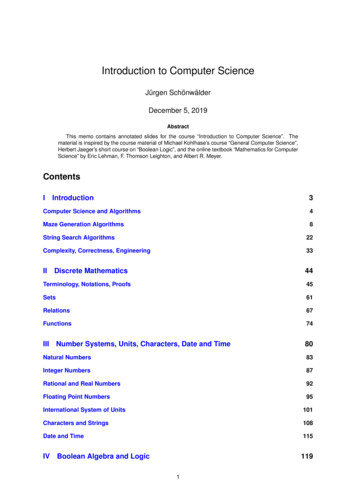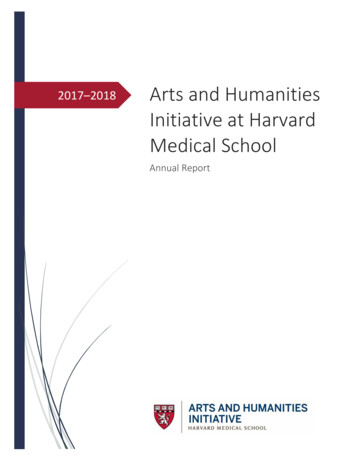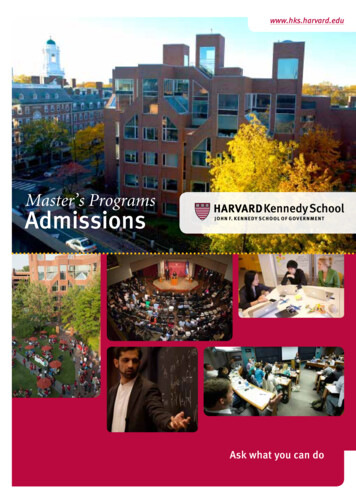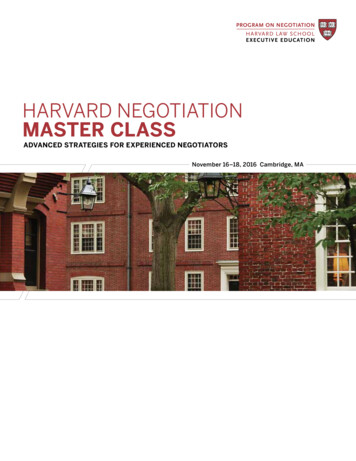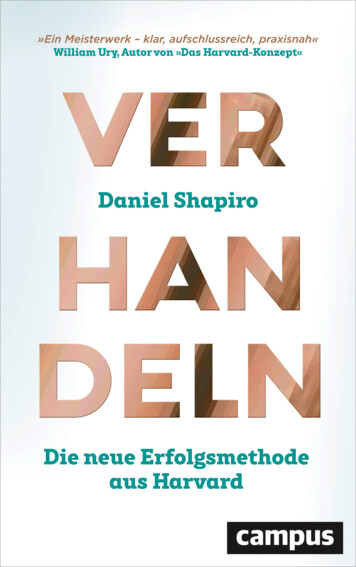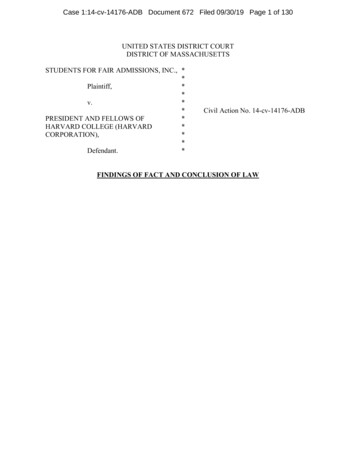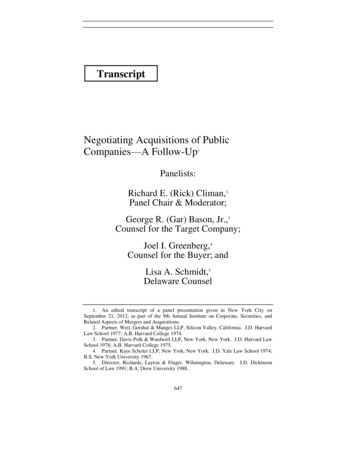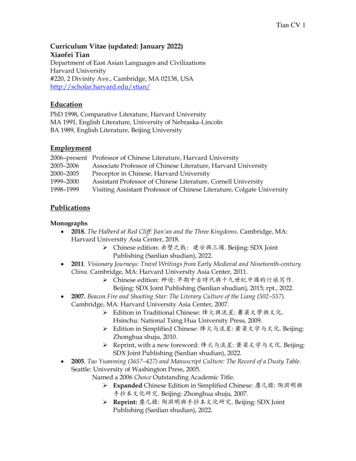
Transcription
Version 3.0Joanna GoodeUniversity of OregonGail ChapmanComputer Science Equity Alliance Computer Science Equity Alliance, 2010Exploring Computer SciencePage 1
Version 3.0AcknowledgementsContributing WritersGeorge Benainous, Hollywood High School, Los Angeles, CaliforniaRobb Cutler, Tutor Crossing, Inc., Santa Clara, CaliforniaJudy Hromcik, Arlington High School, Arlington, TexasMichelle Hutton, The Girl’s School, Mountain View, CaliforniaJohn Landa, South East High School, South Gate, CaliforniaCurriculum Design Team MembersJoanna Goode, University of OregonGail Chapman, Computer Science Equity AllianceJane Margolis, UCLADavid Bernier, UCLATodd Ullah, Los Angeles Unified School DistrictDiane Watkins, Los Angeles Unified School DistrictChris Stephenson, Computer Science Teachers AssociationSponsors & SupportersThis curriculum was created under the auspices of the Broadening the Participation in ComputingNational Science Foundation grant, "Into the Loop: An University K-12 Alliance to Increase and Enhancethe Computer Science Learning Opportunities for African-American, Latino/a, and Female Students inthe Second Largest School District in the Country". Principal Investigator: Jane Margolis (UCLA); CoPrincipal Investigators Joanna Goode (University of Oregon), Todd Ullah (LAUSD), Deborah Estrin(UCLA).Exploring Computer SciencePage 2
Version 3.0CONTENTSCourse Overview . 5Goals . 5Standards . 5Hardware. 5Software . 5Prerequisites. 5The Instructional Philosophy of Exploring Computer Science . 6Introduction to Curricular Approach . 6Concrete Instructional Strategies . 10Assessment. 11Overview of the Instructional Materials . 12Unifying Themes and Practices . 13Scope and Sequence . 14Overview Chart . 17Topic Descriptions and Objectives . 21Unit 1: Human Computer Interaction ( 4 weeks) . 21Unit 2: Problem Solving (5 weeks) . 22Unit 3: Web Design (6 weeks) . 23Unit 4: Introduction to Programming (7 weeks) . 24Unit 5: Robotics (8 weeks) . 25Unit 6: Computing Applications (6 weeks) . 26Unit 1: Human Computer Interaction. 28Introduction. 29Daily Overview Chart . 30Daily Lesson Plans . 31Final Project . 67Exploring Computer SciencePage 3
Version 3.0Unit 2: Problem Solving . 69Introduction. 70Daily Overview Chart . 71Daily Lesson Plans . 72Final Project . 95Unit 3: Web Design . 97Introduction. 98Daily Overview Chart . 99Daily Lesson Plans . 100Final Project . 122Flash Animation Supplement . 125Javascript Supplement . 130Unit 4: Introduction to Programming . 132Introduction. 133Daily Overview Chart . 134Daily Lesson Plans . 135Final Project . 187Unit 5: Robotics. 191Introduction. 192Daily Overview Chart . 193Daily Lesson Plans . 194Final Project . 230Unit 6: Computing Applications . 238Introduction. 239Daily Overview Chart . 240Daily Lesson Plans . 241Final Project . 285Exploring Computer SciencePage 4
Version 3.0Course OverviewGoalsExploring Computer Science is designed to introduce students to the breadth of the field of computer science.The goal of Exploring Computer Science is to develop in students the computational thinking practices ofalgorithm development, problem solving and programming within the context of problems that are relevant tothe lives of today’s students. Students will also be introduced to topics such as interface design, limits ofcomputers and societal and ethical issues of software engineering.This curriculum has been developed for a culturally, linguistically, and socially diverse group of students in LosAngeles Unified School District. District-wide, student ethnicities include .3% American Indian, 3.7% Asian, .4%Pacific Islander, 2.3% Filipino, 73.0% Latino, 10.9% African American, 8.8% White, and .6% Other or multipleresponses. Over 38% of students are English-language learners, with most English language learners studentsspeaking Spanish as their primary language. Furthermore, 74% of students qualify for free or reduced lunches.StandardsThe standards used for the Exploring Computer Science curriculum are based on the topics and goals outlined inA Model Curriculum for K-12 Computer Science developed by the ACM K-12 task force curriculum committee.Most of the objectives in the course align with the Level III course, Computer Science as Analysis and Design,while some objectives are necessarily aligned with the Level II course, Computer Science in the Modern World, inorder to provide appropriate background knowledge for the more advanced topics.HardwareAn ideal laboratory environment for this course would include one computer for each student in the class.These computers can be either Macintosh or PC depending on availability. A networked system would makeinstallation of software easier for the teacher.SoftwareEach computer in the classroom should have a web browser installed that allows students to perform searchesand make use of a variety of websites and internet tools. Teachers will need to download and install the Scratchprogramming language available at http://www.scratch.mit.edu and the Python programming languageavailable at http://www.python.org.PrerequisitesThis course will be considered a college preparatory elective for California students, geared towards 11th and12th graders, and will require Algebra as a course prerequisite. Thus, the course should provide a rigorous, butaccessible, introduction to computer science. No previous computer science course is required to take thiscourse.Exploring Computer SciencePage 5
Version 3.0The Instructional Philosophy of Exploring Computer ScienceIntroduction to Curricular ApproachExploring Computer Science teaches the creative, collaborative, interdisciplinary, and problem-solvingnature of computing with instructional materials which feature an inquiry-based approach to learning andteaching. As part of this curriculum, students will delve into real-world computing problems that areculturally-relevant and address social and ethical issues while delivering foundational computer scienceknowledge to students. Students will engage in several in-depth projects to demonstrate the real-worldapplications of computing.This curriculum builds off of learning theories that view learning as a social and cultural process that doesnot only occur in a vacuum at school; that is, students bring to school bodies of knowledge from theirlives, culture, and communities. Building from students’ prior knowledge, the collection of problemsolving skills, everyday “algorithmic thinking”, and social and ethical knowledge of computer-relatedproblems will result in a more student-centered curriculum. Each unit connects students’ informalknowledge, technology skills, and beliefs about computing to the theoretical and foundational tenets ofcomputer science. Students will become members of a “computing community of practice” in theclassroom where they will be introduced to the behavior, language, and skills of computer scientists.Furthermore, the interdisciplinary nature of computing allows for the incorporation of subject-mattertopics across disciplines into the computing curriculum.The Nine Principles of Learning from the Institute for Learning provide the theoretical foundation ofresearch-based instructional practices that provide the foundation for the Secondary RedesignComprehensive Plan. These nine principles underscore the beliefs of the Los Angeles Unified SchoolDistrict; they are integrated throughout and explain the pedagogy used in the course.1. Organizing for EffortAn effort-based school replaces the assumption that aptitude determines what and how much studentslearn with the assumption that sustained and directed effort can yield high achievement for all students.Everything is organized to evoke and support this effort, to send the message that effort is expected andthat tough problems yield to sustained work. High minimum standards are set and assessments are gearedto the standards. All students are taught a rigorous curriculum aligned to the standards, along with asmuch time and expert instruction as they need to meet or exceed expectations. This principle is one ofthe guiding beliefs common in every school in the Los Angeles Unified School District.2. Clear ExpectationsIf we expect all students to achieve at high levels, then we need to define explicitly what we expectstudents to learn. These expectations need to be communicated clearly in ways that get them "into theheads" of school professionals, parents, school communities and, above all, students themselves.Descriptive criteria and models of work that meets standards should be publicly displayed, and studentsshould refer to these displays to help them analyze and discuss their work. With visible accomplishmenttargets to aim toward at each stage of learning, students can participate in evaluating their own work andsetting goals for their own efforts.Exploring Computer SciencePage 6
Version 3.03. Fair and Credible EvaluationsIf we expect students to put forth sustained effort over time, we need to use assessments that studentsfind fair, and that parents, community, and employers find credible. Fair evaluations are ones thatstudents can prepare for: therefore, tests, exams and classroom assessments as well as the curriculummust be aligned to the standards. Fair assessment also means grading against absolute standards ratherthan on a curve, so students clearly see the results of their learning efforts. Assessments that meet thesecriteria provide parents, colleges, and employers with credible evaluations of what individual studentsknow and can do.4. Recognition of AccomplishmentIf we expect students to put forth and sustain high levels of effort, we need to motivate them by regularlyrecognizing their accomplishments. Clear recognition of authentic accomplishment is the hallmark of aneffort-based school. This recognition can take the form of celebrations of work that meets standards orintermediate progress benchmarks en route to the standards. Progress points should be articulated sothat, regardless of entering performance level, every student can meet real accomplishment criteria oftenenough to be recognized frequently. Recognition of accomplishment can be tied to an opportunity toparticipate in events that matter to students and their families. Student accomplishment is also recognizedwhen student performance on standards-based assessments is related to opportunities at work and inhigher education.5. Academic Rigor in a Thinking CurriculumThinking and problem solving will be the "new basics" of the 21st century, but the common idea that wecan teach thinking without a solid foundation of knowledge must be abandoned, so must the idea that wecan teach knowledge without engaging students in thinking. Knowledge and thinking are intimately joined.This implies a curriculum organized around major concepts that students are expected to know deeply.Teaching must engage students in active reasoning about these concepts. In every subject, at every gradelevel, instruction and learning must include commitment to a knowledge core, high thinking demand, andactive use of knowledge.6. Accountable TalkTalking with others about ideas and work is fundamental to learning but not all talk sustains learning. Forclassroom talk to promote learning it must be accountable to the learning community, to accurate andappropriate knowledge, and to rigorous thinking. Accountable talk seriously responds to and furtherdevelops what others in the group have said. It puts forth and demands knowledge that is accurate andrelevant to the issue under discussion. Accountable talk uses evidence appropriate to the discipline (e.g.,proofs in mathematics, data from investigations in science, textual details in literature, documentarysources in history) and follows established norms of good reasoning. Teachers should intentionally createthe norms and skills of accountable talk in their classrooms.7. Socializing IntelligenceIntelligence is much more than an innate ability to think quickly and stockpile bits of knowledge.Intelligence is a set of problem-solving and reasoning capabilities along with the habits of mind that leadone to use those capabilities regularly. Intelligence is equally a set of beliefs about one's right andobligation to understand and make sense of the world, and one's capacity to figure things out over time.Exploring Computer SciencePage 7
Version 3.0Intelligent habits of mind are learned through the daily expectations placed on the learner by calling onstudents to use the skills of intelligent thinking, and by holding them responsible for doing so, educatorscan "teach" intelligence. This is what teachers normally do with students from whom they expectachievement; it should be standard practice with all students.8. Self-management of LearningIf students are going to be responsible for the quality of their thinking and learning, they need to developand regularly use an array of self-monitoring and self-management strategies. These meta- cognitive skillsinclude noticing when one doesn't understand something and taking steps to remedy the situation, as wellas formulating questions and inquiries that let one explore deep levels of meaning. Students also managetheir own learning by evaluating the feedback they get from others; bringing their background knowledgeto bear on new learning; anticipating learning difficulties and apportioning their time accordingly andjudging their progress toward a learning goal. These are strategies that good learners use spontaneouslyand that all students can learn through appropriate instruction and socialization. Learning environmentsshould be designed to model and encourage the regular use of self-management strategies.9. Learning as ApprenticeshipFor many centuries most people learned by working alongside an expert who modeled skilled practice andguided novices as they created authentic products or performances for interested and critical audiences.This kind of apprenticeship allowed learners to acquire complex interdisciplinary knowledge, practicalabilities, and appropriate forms of social behavior, Much of the power of apprenticeship learning can bebrought Into schooling by organizing learning environments so that complex thinking is modeled andanalyzed, and by providing mentoring and coaching as students undertake extended projects and developpresentations of finished work, both in and beyond the classroom.The units in Exploring Computer Science contain individual lessons that taken together as a unit fit theconstruct for inquiry-based learning outlined in the following chart adapted from the “5 E Model”.Exploring Computer SciencePage 8
Version 3.0The Inquiry-Based Learning Cycle(Adapted from the 5 E Model”, R. Bybee)Stage of Inquiry in anInquiry-BasedSciencePossible Student BehaviorPossible Teacher StrategyAsks questions such as, Why did thishappen? What do I already know aboutthis? What can I find out about this? Howcan I solve this problem? Shows interest inthe topic.Creates interest. Generates curiosity.Raises questions and problems. Elicitsresponses that uncover studentknowledge about the concept/topic.Thinks creatively within the limits of theactivity.Tests predictions and hypotheses. Formsnew predictions and hypotheses. Triesalternatives to solve a problem anddiscusses them with others. Recordsobservations and ideas. Suspendsjudgment. Tests ideaEncourages students to work togetherwithout direct instruction from theteacher. Observes and listens tostudents as they interact. Asks probingquestions to redirect students'investigations when necessary.Provides time for students to puzzlethrough problems. Acts as a consultantfor students.Explains their thinking, ideas and possiblesolutions or answers to other students.Listens critically to other students'explanations. Questions other students'explanations. Listens to and tries tocomprehend explanations offered by theteacher. Refers to previous activities.Uses recorded data in explanations.Encourages students to explainconcepts and definitions in their ownwords. Asks for justification (evidence)and clarification from students.Formally provides definitions,explanations, and new vocabulary.Uses students' previous experiences asthe basis for explaining concepts.Applies scientific concepts, labels,definitions, explanations, and skills in new,but similar situations. Uses previousinformation to ask questions, proposesolutions, make decisions, designexperiments. Draws reasonableconclusions from evidence. Recordsobservations and explanationsExpects students to use vocabulary,definitions, and explanations providedpreviously in new context. Encouragesstudents to apply the concepts andskills in new situations. Remindsstudents of alternative explanations.Refers students to alternativeexplanations.Checks for understanding among peers.Answers open-ended questions by usingRefers students to existing data andevidence and asks, What do you know?ProgramEngageExploreExplainElaborateExploring Computer SciencePage 9
Version 3.0Stage of Inquiry in anInquiry-BasedSciencePossible Student BehaviorPossible Teacher Strategyobservations, evidence, and previouslyaccepted explanations. Demonstrates anunderstanding or knowledge of theconcept or skill. Evaluates his or her ownprogress and knowledge. Asks relatedquestions that would encourage futureinvestigations.Why do you think.? Observesstudents as they apply new conceptsand skills. Assesses students'knowledge and/or skills. Looks forevidence that students have changedtheir thinking. Allows students toassess their learning and group processskills. Asks open-ended questions suchas, Why do you think.? Whatevidence do you have? What do youknow about the problem? How wouldyou answer the question?ProgramEvaluateConcrete Instructional StrategiesThere are several concrete instructional strategies that are included in each unit to implement thisculturally relevant, student-centered, and inquiry-based vision. Each unit begins with a description of the topic, an explanation of the importance of this topic, possiblesocial applications of this topic, and objectives/standards for the unit. Whenever possible, units begin with kinesthetic activity to get students involved in the unit topic.Students are more engaged when they go beyond seatwork to gain familiarity with the scope of a topic.Acting out computing concepts is one way to have students actively engaged in the curriculum. Whenever possible, units present the final unit project at the beginning of the unit so studentsunderstand what type of project they will engage in at the end of the unit. Daily assignments helpscaffold their knowledge towards gaining the knowledge needed to complete a particular project. Thefinal project represents a culmination of their new knowledge and provides an opportunity to expandtheir understandings to a particular socially-relevant problem. Computing terms and definitions are explicit and part of the instruction. The curriculum avoidsunnecessary jargon which might distract learning of the critical content. Students have opportunities touse writing to reinforce the literacy component behind these computing terms and definitions. Foundational computing topics are connected to the ‘pop-technology’ students have likely encountered:cellular phones, iPods, MySpace / Facebook, blogs, Internet browsing, etc.Exploring Computer SciencePage 10
Version 3.0 Whenever possible, real-world problems are presented in the context of socially-relevant issuesimpacting urban communities (housing, safety, poverty, health care, access to equal rights, educationalopportunities, improving social services, translation services, transportation, etc.) Student have opportunities to work on problems that they help define and can individualize – i.e.selecting their own content for Web sites; creating original, not pre-scripted, problem-solving strategies,etc. Activities are designed to encourage students to work in a variety of collaborative settings: peerprogramming, group research projects, etc. which encourage conversations around computing topics. Students will experience a variety of ways to communicate their answers – academic writing, writing aletter to a friend or companion, using presentation software, developing graphics or animation, listingalgorithms, drawing illustrations, oral presentations, etc. Units incorporate examples of careers in computing as they arise in the curriculum. Students will begiven hypothetical opportunities to act as a professional to take on the behavior and skills to solve agiven problem. Though using technology is a core component of this curriculum, using computers is not necessarilyembedded in the curriculum on a daily basis.All of these strategies contribute to developing the problem solving skills and algorithmic thinking processes thatare emphasized throughout the course.It is important to note that each unit focuses on different instructional strategies; this is purposeful. In somecases, it is because the particular subject matter lends itself more successfully to a particular set of strategies,but this was also done to highlight the wide variety of possible strategies that can be used effectively in teachingthis course. We encourage teachers to experiment by trying strategies that work well for them in a variety ofdifferent places in the curriculum. For example, the peer review process utilized in Unit 4 could be adapted foruse in other units; the idea of an “elbow” partner can be used in all units. Journal responses and blog entriescan be used by students to communicate about their work in any of the units. There are many other possibilitiesto consider.AssessmentWith the exception of the final projects, there are no specific assessments listed in the lesson plans. There arealso very few specific “homework” assignments. Differences in grading policies, types of assessments required,and student schedules make it difficult to gauge the best combination of assessment tools to use in a particularenvironment. Teachers are encouraged to determine which class activities might lend themselves to someresearch outside of class and which might make useful assessments. Additional assessment instruments can bedeveloped by individual teachers or teacher teams. All forms of assessment should meet the criteria outlined inthe Nine Principles of Learning.Exploring Computer SciencePage 11
Version 3.0Overview of the Instructional MaterialsThe pages that follow contain the core of the materials teachers will need in order to plan and deliver ExploringComputer Science. The materials begin with the unifying themes and practices that are woven throughout thecourse followed by a Scope and Sequence chart that details the various topics included in the course, along withthe unit in the course where each is introduced and reinforced. Teachers should continue to refer back toprevious units where appropriate. For example, Unit 3 builds on many of the Unit 1 concepts by taking studentsfrom discussing and viewing websites to actually using and developing them. The approximate time allotmentnoted in the chart includes all activities from introduction through application.Following the Scope and Sequence is an overview of each unit that includes the unit description and overallobjectives of the unit. There is also a table that indicates the topics for each instructional day of the course.Finally, are the daily lesson plans with detailed student activities and teaching strategies for each day. Eachlesson has been built on a 55 minute class period. In schools where class periods are shorter or longer (or onvarying block schedules) adjustments will need to be made; such adjustments may include combining lessons(for longer class periods) or assigning parts of t
Version 3.0 Exploring Computer Science Page 5 Course Overview Goals Exploring Computer Science is designed to introduce students to the breadth of the field of computer science. The goal of Exploring Computer Science is to develop in students the computational thinking practices of algorithm development, problem solving and programming within the context of problems that are relevant to

